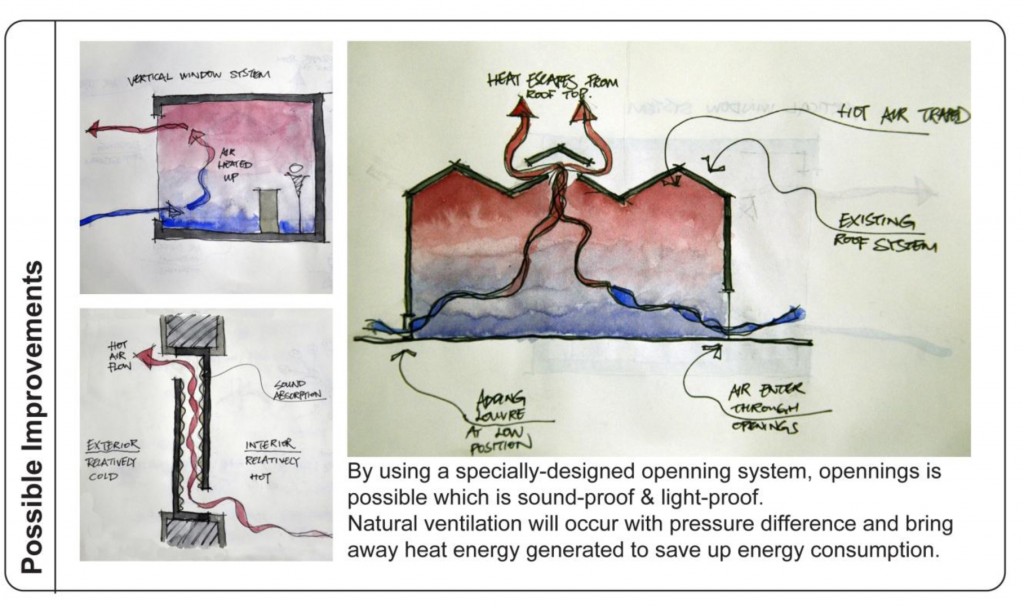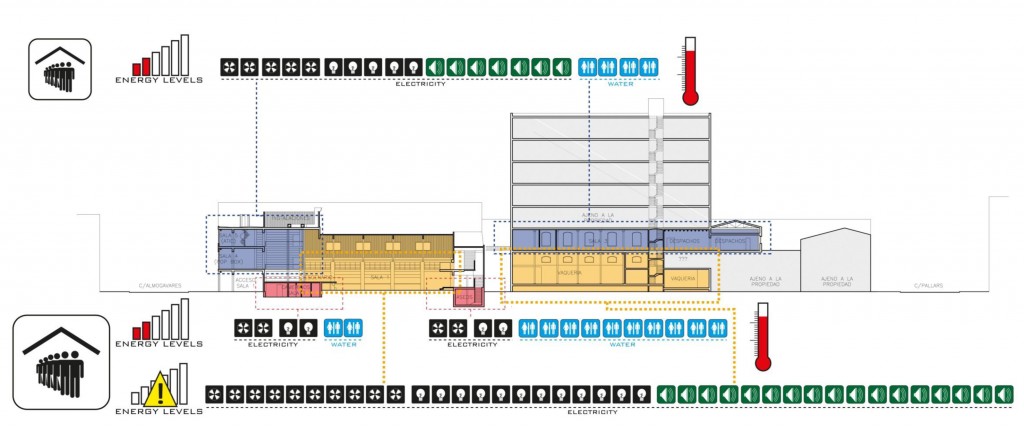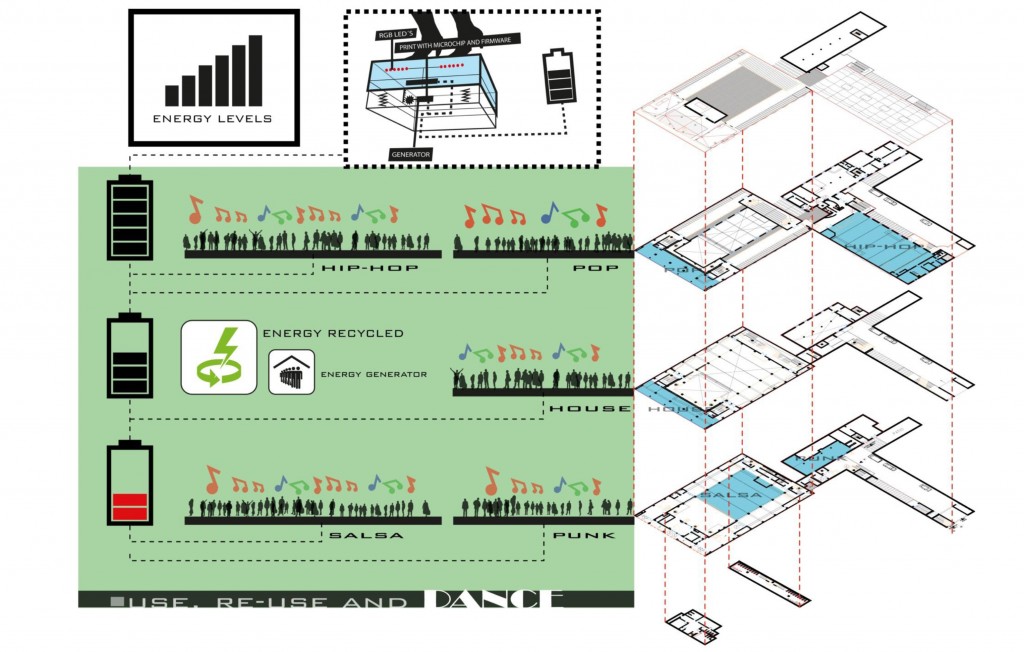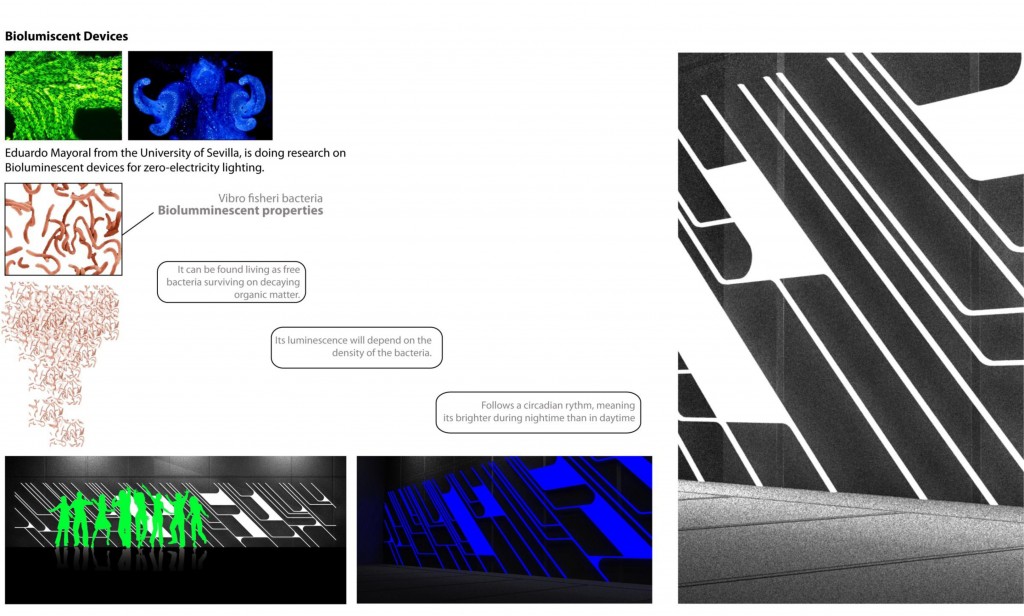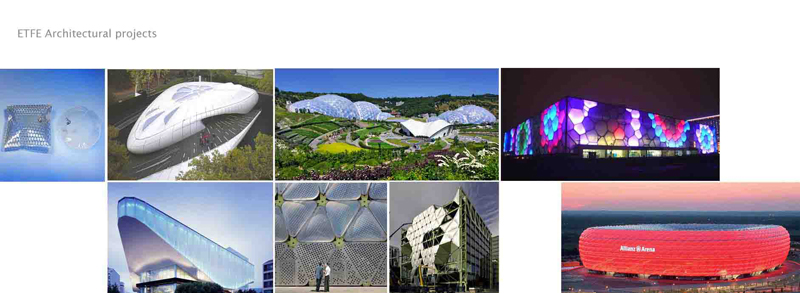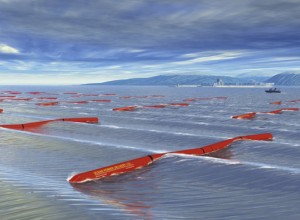home
Phases
Category Archives: IC.2 Energy
Final Submission ::: Energy
Also posted in Alessandra Antonetti, Golrokh Shahbaz, Guruprakash Gonvidasami, HUNIA TOMOUM, Minu Surana, Students, Uncategorized Comments closed
Razzmatazz – Dancing Energy
RAZZMATAZZ ANALYSIS
Ventilation:
Works 100% on artificial ventilation since all the windows are sealed in order to keep the sound inside to avoid sound pollution. Strategy: Reduce the usage of artificial ventilation
MISTING SYSTEM
Consist on introducing ultra-fine water droplets into the atmosphere so they can quickly absorb the energy present in the environment and boil off (evaporate). The energy (heat) that is used to produce this state, change from liquid to gas, is eliminated from the atmosphere, hence the air is called by the process called evaporative cooling.
Energy Generation:
The concentration of people dancing creates an energy that should be considered. Strategy: Generate energy with the dance floor.
Material Cycle:
One night with full attendance will use 3750 plastic glasses that are thrown to the garbage. Strategy: Alternative materials for glasses.
Lighting:
The current incandescent-lighting system produces more heat than lighting. Creating more energy consumption on ventilation system. Strategy: Alternative ways for lighting.
The new proposal for the Razzmatazz promotes the creation of opened holes at the roof of the “salas”. By doing so air keeps moving from the bottom to the top, the water drops with the heat turn into vapor and then go out with the air. This system will work in a big space like razzmatazz’s dancing room because the air can moves quickly inside.
Lots of factories in China are using this system in the interior instead of A/C systems, it is cheap and effective. It was also used at Shanghai expo 2010.
The A/C system is a filter for vapor, it inhales the vapor and disposes of the water sending filtrated dry air out. That is why people feel dry in small rooms with the A/C system on.
Also posted in Anna Popova, Esteban Sepulveda, Jianhong Wu, Lok Man Lee, Marco Manduzio, Nicolas Fueyo, Seif El-Din Shawky, SEIICHI EDUARDO SUZUKI ERAZO, Students Comments closed
Eco-Friendly Material – ETFE
source: grimshaw architects, eden project, England
ETFE foil is fast becoming one of the most exciting materials in today´s design industry and has set the construction world alight with the potential it offers. Originally invented by DuPont as an insulation material for the aeronautics industry, ETFE was not initially considered as a mainstream building material. Its principal use was as an upgrade for the polythene sheet commonly used for greenhouse polytunnels. The advantages of its extraordinary tear resistance, long life, and transparency to ultraviolet light offset the higher initial costs, and over 20 years later, it is still working well.
The Eden Project in the UK and the Beijing Olympic Aquatics Centre has brought the material into public discussion. ETFE is increasingly being specified on a wide range of new projects, from schools and offices, to government buildings and sports facilities. ETFE is under the spotlight and intends to shine.
ETFE foil is essentially a plastic polymer related to Teflon and is created by taking the polymer resin and extruding it into a thin film. It is largely used as a replacement for glazing, due to its high light transmission properties. Transparent windows are created either by inflating to or more layers of foil to form cushions or tensioning into a single-skin membrane.
Weighing approximately 1% the weight of glass, simple-ply ETFE membranes and ETFE cushions are both extremely light-weight. This enables a reduction of structural framework and imposes significantly less dead load on the supporting structure.
Another major benefit of ETFE is its high translucency. Transmitting up to 95% of light, it is easy to see why it was chosen to construct Eden Project. When high levels of light and UV transmission are not required, ETFE also has the ability to be printed or fritted with a range of patterns. This fritting can be used to reduce solar gain while retaining transparency or it can incorporate a white body tint to render the foil translucent. ETFE cushions can be lit internally with LED lightning to make them glow or may be projected onto externally like a giant cinema screen, creating dramatic results.
Unaffected by UV light, atmospheric pollution and other forms of environmental weathering, ETFE foil is an extremely durable material. While no ETFE structure has been in place for longer than 25 years, extensive laboratory and field research have suggested that the material has a lifespan in excess of 40 years.
The benefits of this material are extensive and have yet to be put to use in many areas.
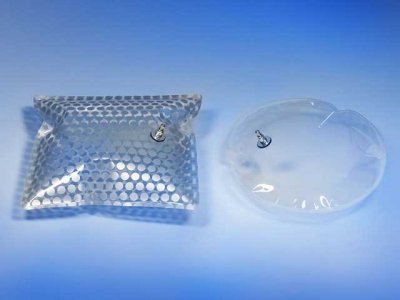
Bibliography:
WILSON Amy, 2009, ETFE: The new Fabric Roof
Also posted in SEIICHI EDUARDO SUZUKI ERAZO, Students Comments closed
Eco-Friendly Materials
Cork:
Cork is a natural, organic, sustainable product that is soft to the touch, feather light yet durable, fire resistant and waterproof. It is used for a variety of products such as flooring, architectural cladding panels and designers are now creating eco-friendly cork handbags and other cork fashion and home accessories that are stylish as well as functional it’s becoming the new alternative for eco-friendly fashion and decorating. On the other hand cork can be a padding material for other architectural material like flooring tiles or elevation panels and can be the thermal and water insulation material.
Harvesting Cork oak is one of the best examples of a sustainable agro-forestry system where people use the natural resources, without disturbing or destroying nature. Cork oak trees are unique in their ability to regenerate after their bark has been harvested. This means that cork forests undergo fewer disturbances than conventional commercial forests, creating a unique and valuable eco-system. FSC (Forest Stewardship Council) certification is considered the best way to protect this environment for the long-term benefit of communities living and working in these regions, as well as the indigenous wildlife. The attached link is an interesting clip for cork harvesting.
http://www.youtube.com/watch?feature=player_embedded&v=cpIfVT7BA6g
ETFE:
Ethylene tetrafluoroethylene, ETFE, a fluorine based plastic was designed to have high corrosion resistance and strength over a wide temperature range. It can be used for insulation, as well as temperature and light regulation. ETFE is a growing trend in architecture these days because it enables new design options.
ETFE foil is a perfect covering for a greenhouse because it is strong, transparent and lightweight. A piece of ETFE weighs less than 1 percent of a piece of glass with the same volume. It is also a better insulator than glass, and it is much more resistant to the weathering effects of sunlight. The material is self cleaning because of its chemical composition (very similar to teflon). In most architectural applications the material is used in ETFE Pillows. This configuration is a composite of two layers of ETFE that are pressurized to form a more rigid unit. Typically, aluminum strips are sandwiched along the edges to seal the pillows with just a small pressurization hose penetration left open. The amount of light that passes through membranes can be regulated, because membrane cushions with an inner coating of tungsten trioxide turn blue when they come into contact with hydrogen and lose their color if the cushions are filled with oxygen You could use a foil such as this to cover the entire facade of a house and have light pass depending upon sunlight conditions.
Also posted in Ahmad Derhalli 1 Comment
IC2 Empuries Energy
EMPURIES SELF-SUFFICIENCY
We have selected, based on the developed analysis some strategies to achieve a level of self-sufficiency in terms of energy in the hostal.
We start the energy production research from the fact that there are some important energy sources to consider in the site, taking advantage of the obvious position of the hotel in front of the sea.
There exist a series of considerations to take in mind before choosing any ocean, sun or wind energy production method, such as the possible impacts on the shape and aesthetics of the beach, very important because the main attractor of the hostel is its beautiful environment, and its alteration might bring with it a serious economic impact, so any method that permanently alters its context should be avoided.
The development of the research can be found in the research document by clicking here.
Also posted in Alejandro Nuñez López, Angel Fernando Lara Moreira, Gabriel Bello Diaz, Maria Elena Amescua Dacasa, Noor Alain Ahmed, Oscar Gomez de la Vega, Pavel Aguilar Urquidez, Shruthi Basappa Comments closed












